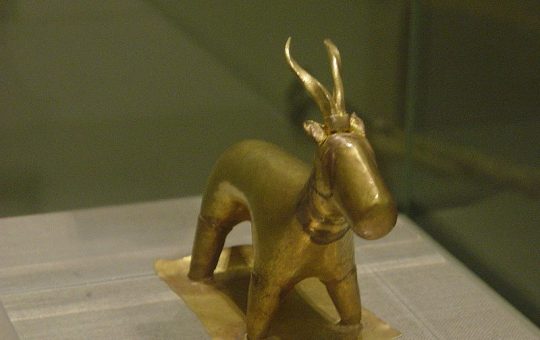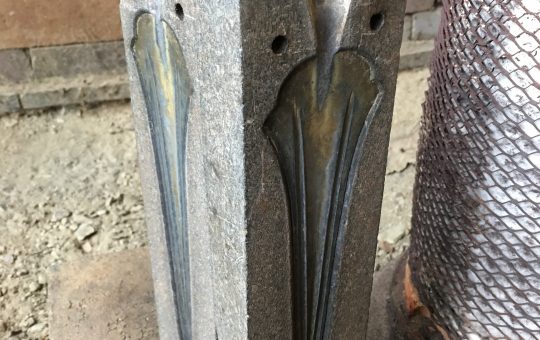Making a Sword At Molten Bronze: What to Expect
By Dan Goss, who made a bronze sword here on 21/04/2018
I’ve always wanted to make a sword. Since I was little, I watched the swordsmiths in films and read about ancient craftsmen with complete fascination. It was on one of my more recent research sessions that I found a video on YouTube about how you can make your own sword, straight from the depths of the Bronze Age, and by the time I’d finished watching it, I was hooked. I got in touch with Dave at Molten Bronze the next day.
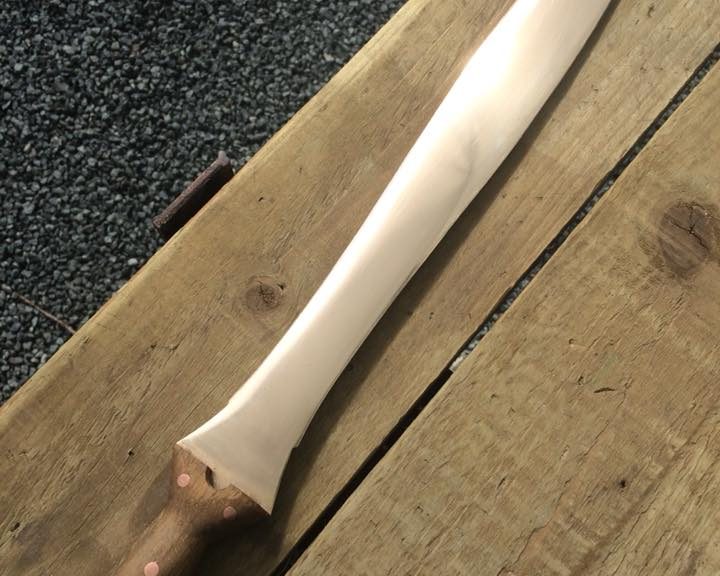
The Build-Up
He was quick to get back to me and really helpful with dates, bookings and information. I’d asked around, and a group of my friends all wanted to go to the Foundry and make swords, but even with the hassle of trying to arrange 12 would-be smiths all at once, booking the weekend was a breeze.
Arriving to The Foundry
It was unfortunately quite late at night when we arrived, and though Dave was already asleep in preparation for a big day of casting, Erika was up to greet us and make sure we were welcomed in. We had tea and snacks while she explained everything to us, and got us settled in to where we’d be sleeping – a lovely spacious room at one end of the house, and a smaller outbuilding which was equally inviting and cosy. The house is beautiful, and was our first clue that this weekend was going to be even better than we’d imagined.
Our First Morning as Sword-Makers
Breakfast was early, but we didn’t mind – Erika had made it for us and it was fantastic. Soul food. We were all excited to get going, and people began trickling outside to watch the furnace being set up as soon as they’d finished their meals.
While Dave set up the furnace, he explained what his bronze consisted of, and what these swords would have historically been made with. Unlike some ancient bronze, which was often made with copper and lead or arsenic, Dave smelts the traditional British and Irish Bronze-Age formula of copper and tin, which produces a strong, versatile, and – importantly – non-toxic metal.
The First Casts
We got the chance to see the molten bronze in the crucible, and a few intrepid smiths looked over into the furnace and saw an incredible mirror-like surface, formed by the liquid bronze. It almost looked like an optical illusion, it was so perfectly reflective.
While it was coming up to temperature, Dave put together the pre-heated soapstone dies for the blade, showing us the impression of the sword and demonstrating other sorts of dies which would have been used in the Bronze Age. Soapstone is the traditional material thanks to its ease of carving and resistance to large temperature changes – most other stones would crack when molten metal is poured into them!
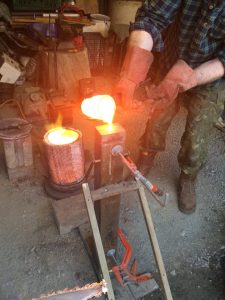
The actual bronze casting itself was awesome – and I mean that in the original sense of the word. The glowing crucible, the light from the pouring metal, the sound as it cooled in the dies… it was amazing to watch.
After a few minutes, Dave cracked the dies open, and we saw the first sword we’d be working with.

The Work of Making a Sword
Once the metal had cooled, the sprue – the cone of metal that remains attached to the casting, where it was poured into the dies – was removed, and then we got to the real work of making a sword. The first thing we had to do was recover the excess bronze that had seeped around the edges of the blade, which we did by twisting it off with pliers and saving it in a can for later reforging. Back in the day, it would have been vital to recover every wasted crumb of bronze, as it was a very valuable commodity.
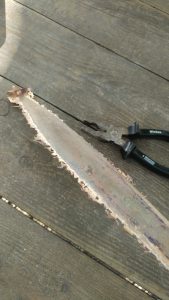
Dave then stepped in to save us weeks of filing by tidying up the edges of the blades with a grinder. It may have been a little modern for the bronze-age smith, but it meant we could finish the swords in a weekend rather than over the course of a season, so we were pretty pleased about it.
At that point, the swords looked something like this:
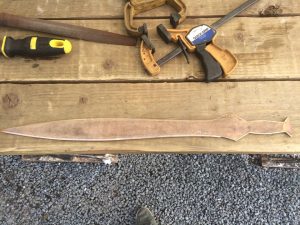
Lunch
We were all very ready for lunch when Erika called us in, and it was just as great as breakfast had been. We had all been wrapped up in the work and hadn’t realised it, but we were starving, and the home-cooked food was exactly what we needed.
The Rest of the Day
We started work on the blade itself with files, grinding off the rough outer surface and revealing a shining underside. The files got this done pretty quickly, (and filing off the rough exterior was super satisfying work) but they also left deep scratches all over the blades, which we would have to smooth out with sandpaper.
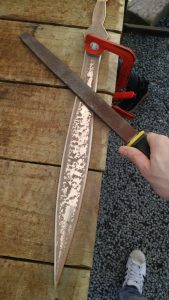
Something I wasn’t expecting when making a sword was that where we found a persistent bubble in the swords – an unfortunate reality for ancient casting techniques – we filled it with a more malleable and easier-to-melt metal: silver. Only one or two of the swords needed this treatment, but it was fun to watch and gave the blades some character – one of my friends ultimately named his “Silvereye” for the point of bright silver fused to the bronze.
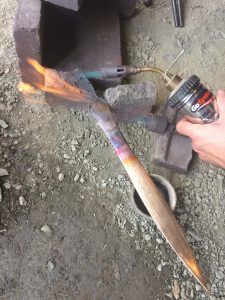
After that, it was back to the sandpaper. By the time dinner came around, we were very ready for it.

Saturday Night
On Saturday night we enjoyed a few drinks, and stayed up late talking. It felt like more of a connecting experience than usual – I think we were all a little buzzed from the day’s crafting. We also enjoyed some incredibly immersive Bronze-Age culture – though I won’t spoil that surprise for you.
Sunday: Putting the Finishing Touches On
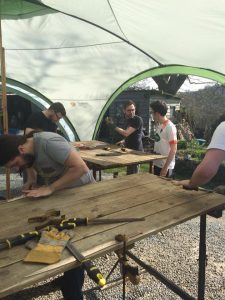
By Sunday, most of the work of making a sword had been done. We just needed to add our handles, and finish the blades with sandpaper and polish. In keeping with accuracy (and the traditional composition of the sword), the handle is made from English Oak, held in place by copper pins, and burned to the tang of the blade. I wish I’d managed to get a video of the moment they were burned on, creating a perfect fit – there was a spectacular jet of flame and a huge amount of smoke as the wood conformed to the hot metal.
We shaped the handles with files, and then graduated to sandpaper, finishing up with a gorgeous handle that’s comfortable and secure.
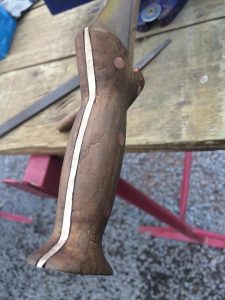
The last thing we needed to do then was sand and polish our swords to a mirror shine, and sharpen the edges. After hours of careful filing, sanding and polishing, it felt wrong to take a file to the blade again, and we were all very careful only to wear away the edges. Bronze can be sharpened to a razor’s edge, and it’s easy to see why it was the material of choice for swords and spear-tips.
Not only is it functional – it’s beautiful. As a status symbol for an ancient king or a weapon to vanquish an enemy army, you couldn’t ask for better.
A Little Ancient Education
One of Dave’s friends, a retired military close-combat trainer, came over when we were finishing up to show us a thing or two about the weapons we’d just made. She took us through the development of the blade and how it affected warfare; the way it would have been used; and the incredible deadliness of the ancient swords. The reconstructions we made are real swords, and are not toys – after a few minutes of watching her work, we all understood that very well.
After the demonstration, Erika recommended going somewhere quiet to contemplate what we had created – a spiritual, archetypal thing that will outlive us. It had been summoned out of the far ancient past, and here we were, holding it. That was something remarkable, she said, and worth paying respect to.
Home
We were done by 4pm, and off home. Exhausted, hands greenish with copper, and with a car boot full of swords, I might as well have been riding home on a sunbeam, I was so delighted with the weekend – and what we’d made.
If You Want To Make A Sword
If you’re interested in making your own sword, you can get in touch with Dave on this site using the contact page, and by emailing Dave at dave@bronzeagefoundry.com
I can’t recommend it highly enough. I feel like doing this as a group has brought our friendship closer, and given us all a shared memento of having done something amazing.
It’s sitting on my desk right now, in pride of place. One of the most beautiful things I think I’ll ever make, a piece of ancient history remade, and a reminder of a genuinely fantastic weekend in the Welsh Countryside.


